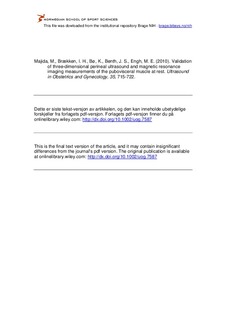Validation of three-dimensional perineal ultrasound and magnetic resonance imaging measurements of the pubovisceral muscle at rest
Journal article, Peer reviewed
Permanent lenke
http://hdl.handle.net/11250/170673Utgivelsesdato
2010-02-22Metadata
Vis full innførselSamlinger
- Artikler / Articles [2119]
Originalversjon
Ultrasound in Obstetrics & Gynecology. 2010, 35(6), 715-722Sammendrag
Objective: To compare biometric measurements of the pubovisceral muscle during rest, measured using transperineal three-dimensional (3D) ultrasound and magnetic resonance imaging (MRI). Methods: In this prospective study, 18 female volunteers underwent 3D perineal ultrasound examination and MRI. All women were examined at rest in the supine position and the following measurements were taken: area and anteroposterior and transverse diameters of the levator hiatus; thickness of the pubovisceral muscle, measured lateral to the vagina and to the rectum, on the right and left sides; length of the levator–urethra gap (LUG), measured from the center of the urethra to the insertion of the pubovisceral muscle on the pubic bone. Interclass correlation coefficients (ICC) between the measurements obtained with 3D ultrasound and with MRI were calculated. To quantify the intermeasurement agreement, the bias and SDs were calculated, and limits of agreement constructed. One investigator performed all the analyses. Results: There was no significant difference between the mean values of the measurements by 3D perineal ultrasound and those by MRI. The ICC values showed very good agreement (range, 0.80–0.97). There was a significant positive bias for LUG on the left side and muscle thickness on the right side of the vagina. Conclusion: These results suggest that 3D ultrasound could be used instead of MRI when evaluating static pelvic floor anatomy in women without pelvic organ prolapse at rest.
Beskrivelse
I Brage finner du siste tekst-versjon av artikkelen, og den kan inneholde ubetydelige forskjeller fra forlagets pdf-versjon. Forlagets pdf-versjon finner du på onlinelibrary.wiley.com: http://dx.doi.org/10.1002/uog.7587 / In Brage you'll find the final text version of the article, and it may contain insignificant differences from the journal's pdf version. The original publication is available at onlinelibrary.wiley.com: http://dx.doi.org/10.1002/uog.7587
